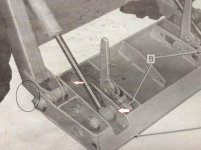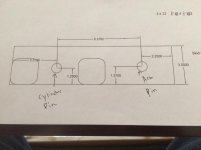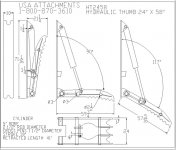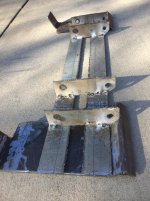jimybuddiesel
Plastic
- Joined
- Jul 20, 2015
I am wanted to calculate how much additional distance I will need between pins to eliminate 1/2 inch of overhang of the quick attach when in the complete down position. A link to a formula or a math equation for calculation would be appreciated.
Assume the cylinder stroke is 12 inches.
Current pin distance is 6.3762
distance from the arm pin to the bottom of the quick attach is 2.25 inches.
below is some extra detail. I have also provide photographs to help with the explanation.
I am replacing my quick attach to the "bobtach standard". In the new system, when the bucket is all the way in dump position,it is impaired by the base plate. I would need another 1/2 distance for it to clear. The circle in the first photograph shows the issue point. The arm extends 1/2 inch past flush with the quick attach, and I would like to eliminate by lengthening the distance of the cylinder pin.
Currently the distance between the two pins is 6.3762. I am assuming that moving the cylinder pin further from the arm pin, assuming the cylinder stroke is constant will eventually eliminate the 1/2 past flush current issue. The second photograph is shows a side view of pin location and distance from pin,and also side view measurements of the proposed quick attach.
The tractor is in the field, so I can not get an accurate measurement of the stroke, but I believe it is approximate 12 inches.


Assume the cylinder stroke is 12 inches.
Current pin distance is 6.3762
distance from the arm pin to the bottom of the quick attach is 2.25 inches.
below is some extra detail. I have also provide photographs to help with the explanation.
I am replacing my quick attach to the "bobtach standard". In the new system, when the bucket is all the way in dump position,it is impaired by the base plate. I would need another 1/2 distance for it to clear. The circle in the first photograph shows the issue point. The arm extends 1/2 inch past flush with the quick attach, and I would like to eliminate by lengthening the distance of the cylinder pin.
Currently the distance between the two pins is 6.3762. I am assuming that moving the cylinder pin further from the arm pin, assuming the cylinder stroke is constant will eventually eliminate the 1/2 past flush current issue. The second photograph is shows a side view of pin location and distance from pin,and also side view measurements of the proposed quick attach.
The tractor is in the field, so I can not get an accurate measurement of the stroke, but I believe it is approximate 12 inches.










